THE LANDSCAPING SOLUTIONS BLOG
Welcome to our Blog. Inspiration, updates and industry trends from the team at Landscaping Solutions.
BEWARE GREENWASHING
There are better ways to improve a company’s carbon footprint than carbon offsetting and mass tree planting schemes, says Landscaping Solutions MD Ben West.

Large companies will often offset their carbon footprint through mass tree planting schemes.
It’s wonderful to see once marginalised environmental issues becoming mainstream concerns, but we must ensure that action in these areas is both genuine and focused in the right direction. We must beware of ‘greenwashing’. Unscrupulous marketing departments have latched on to the fact that environment and sustainability issues are making headlines and are exploiting consumer naivety, a lack of consensus and toothless regulatory frameworks to increase sales and enter new markets. This seeds mistrust, confusion and apathy in the consumer. Research has shown that consumers can become indifferent or indeed harbour negative feelings towards green marketing, legitimate or otherwise, following sustained exposure to greenwashing.
Companies can declare sustainable credentials through carbon offsetting. What is carbon offsetting? In the simplest terms it is the balancing out of an individual’s or company’s carbon emissions by their funding an activity that involves the sequestering of carbon. A plane passenger travelling from London to Amsterdam can ‘offset’ a proportion of the carbon produced by that flight against the carbon sequestered by a tree planting scheme they have funded. Offsetting as part of a long-term plan for culture change is to be admired and encouraged but all too often these schemes are reminiscent of the absent father sending money to the kids whilst he’s away on ‘business’ with the secretary. Offsetting schemes assuage guilt without addressing the underlying issues - which is probably why fossil fuel companies like them so much.

Some airlines use tree planting schemes so they can offer passengers the opportunity to offset a proportion of the carbon produced by their flight.
Can we really buy our way out of the climate crisis? Carbon is best left where it is - in the ground. It’s not enough to carry on business as usual whilst throwing money at offsetting schemes which are at best well-intentioned but ineffective and at worst cynical and damaging. A better policy is to protect existing natural systems whilst rewilding wherever possible. The best way to plant trees is to allow them to regenerate naturally. Jays and squirrels plant trees throughout the autumn for free. This is much more sustainable than armies of trees planters driving to remote sites and much more likely to succeed.
Take a look at the images of HS2’s failed attempts to greenwash the impact of their atrocities in the Chilterns; fields full of plastic tubes containing dead and dying saplings. Remember that the thorn is the mother of the oak; a tangle of thorny scrub (possibly the most undervalued of all our native habitats), consisting of hawthorn, dog rose, blackthorn and bramble is a far more effective nurse to the species that will eventually become climax woodland: ash, oak and beech.
In any case we shouldn’t get too fixated on tree planting as a panacea for all our climate and biodiversity ills. We need a diverse mosaic of habitats to contribute to carbon fixing and biodiversity gains. Woodland is well down the pecking order when it comes to holding carbon in the landscape. Seagrass meadows, mangroves and salt marshes are all examples of habitat that are ahead of woodlands in the carbon fixing stakes. Top of the list are peatlands: tundra, bogs, fens, moorland, meres and mires. These are the very habitats that some elements of our industry are keen to see relocated and releasing carbon in pots, planters and borders up and down the country. We damage these habitats, and unlock carbon in the process, when we disturb them. Disturbance includes planting trees on them, as well as on heathland, ancient woodland and a host of other fragile and threatened habitats. This has happened throughout the twentieth century in this country and may continue should we blindly pursue ill-conceived carbon offsetting schemes or political promises geared to gaining the popular vote at the ballot box.
ILLUMINATING THE PROBLEM
How damaging is artificial lighting to the environment? Landscaping Solutions MD Ben West considers the impact.

Artificial light can adversely impact the behaviour of birds.
We don’t have lighting in our garden. The generosity of the local borough council is such that all the light we need, and pools more, is gathered from an adjacent lamp post. Indeed ‘light trespass’ from this single luminaire infuses evening al fresco dining with all the charm of a Gestapo interrogation. The offending street lamp has recently been limited to operation from dusk until midnight, presumably as a cost cutting measure but possibly also as a response to emerging evidence of the negative effects of artificial light on the environment.
Recent studies, particularly those undertaken by the Environment and Sustainability Institute at the University of Exeter, have revealed artificial light to be adversely impacting the behaviour of a much wider range of species than myself and the missus. Birds are particularly affected with physical reproduction traits and behaviours being modified. Bird movements are also being disrupted, along with those of bats and fish, as navigational ‘signposts’ such as starlight, moonlight and diffuse natural light in the atmosphere are obscured or obliterated by ‘Skyglow’ from artificial light. This phenomena is observable many miles from source, can be equal to or exceed light intensities produced by moonlight and sufficient to mask natural lunar light cycles.
Light pollution is a relatively new phenomenon so the long term effects on biodiversity are unknown. However, the short term effects are obvious; leave a window open on a summer’s evening and it’s clear that artificial light has an effect on night flying insects such as moths. Is there a link between the reported declines in moth numbers over the past thirty years and the increase in artificial lighting during the same period? It’s too early to answer questions like these definitively but it’s easy to test the hypothesis; switch out the lights and the problem disappears. Knowing the detrimental effects on wildlife, can we continue to freely prescribe lighting in our design work? Maybe it’s time for a more measured approach. Let’s look at the facts;
The relative impact of different types of lighting depends on where they are on the spectrum. Different kinds of lamp emit light over a distinctive range of wavelengths. Light becomes more environmentally impactful in the following ways;
a) As it becomes broader on the spectrum (or ‘whiter’).
b) As the ratio of blue to red emissions increases.
c) With increased emissions in the UV (ultraviolet) range.
The broader the spectrum the more overlap with the sensitivity of biological systems. Lighting toward the red end of the spectrum is generally thought to be less impactful to the environment though this also has a bearing on the ability of birds to migrate and has an effect on plant physiology.
Light-emitting diode (LED) lighting systems require lower wattage than traditional light sources and produce lower radiant heat for the same light output. They have a longer working life and allow easy light level manipulation. Unfortunately they utilise white light which is disruptive to natural systems and the blue component is disruptive to human circadian rhythms.
So what should we be doing as environmentally conscious professionals?
- Maintain naturally unlit areas wherever possible.
- Specify light only where there is clear, sufficient and necessary human benefit. - Provide barriers to ‘light trespass’ such as covers or hoods, walls, screens and evergreen hedges.
- Ensure lighting is switched on only when needed by utilising motion control
- Disseminate knowledge to clients to raise awareness.
- Use LED lights on as dim a setting as possible.
- Avoid use of white and blue lights and fittings which emit UV light.
THE SUSTAINABLE AESTHETIC
In late 2019 we collaborated with Jilayne Rickards on a small urban garden she designed for a great client in North London. Jilayne christened the scheme ‘The Urban Retreat’.
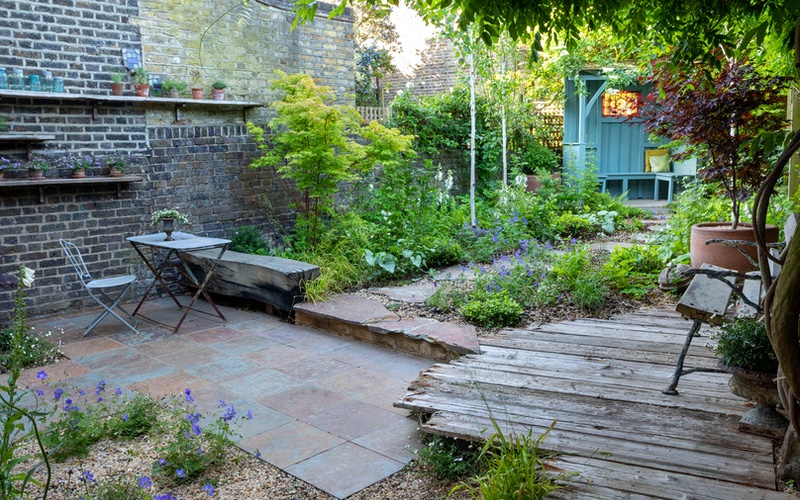
The Urban Retreat in North London, designed by Jilayne Rickards and built by Landscaping Solutions.
Jilayne’s vision was for the garden to be both beautiful and sustainable. In December last year we discovered the garden had picked up four British Association of Landscape Industries awards. The most satisfying of these for us was the award for best use of recycled and reclaimed materials. The recognition this garden received from BALI and the interest and acclaim it has garnered from the wider public offers hope for what we call ‘The sustainable aesthetic’. The more media coverage gardens of this type obtain the more they will come to be considered desirable by the general public and the more likely their guiding ethos will become mainstream thought.
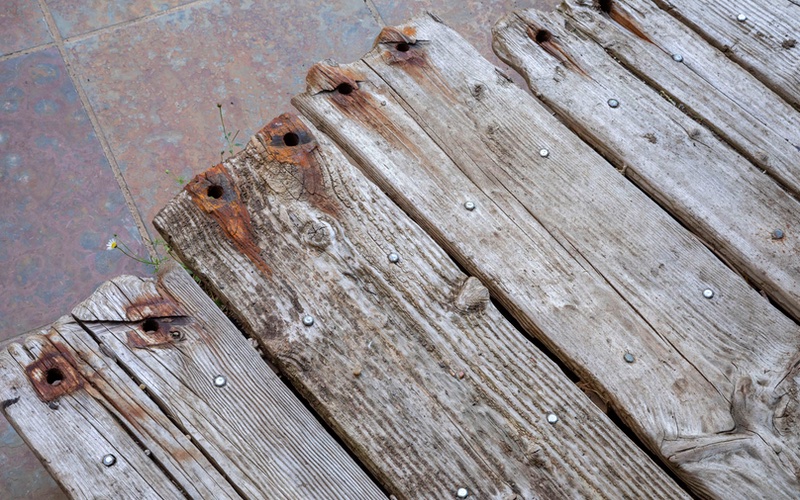
Reclaimed Douglas Fir decking, one of the many recycled and reclaimed materials used throughout the garden.
What is the ethos of the sustainable aesthetic and why is it important? The sustainable garden weathers well in the British climate, blends in with its surroundings, accommodates and encourages interaction with wildlife and does not damage the environment in its creation. It follows a number of principles;
Protect and nurture the holy trinity of soil, plants and insects. Do this and good things will follow. In ‘The Urban Retreat’ all soil was kept on site.
Reduce waste. In this garden all existing pots and planters were recycled along with the brick work. Paving sub-base materials were re-used where appropriate or sent for off-site recycling with any green waste produced. Energetic waste can also be reduced by designing closed systems and features that have multiple benefits. For example, planting Comfrey for its aesthetic appeal, ability to attract and feed insects, provision of composting material and medicinal applications.
We can further reduce waste by working with the existing lay of the land, soil type, microclimate, ‘hard’ and ‘soft’ vernacular, moisture levels, ‘habitat’ type, etc. The existing garden had a woodland edge feel and Jilayne used this to inform her plant choices. Woodland edge gardens are cooling and relaxing in the heat of a city summer.
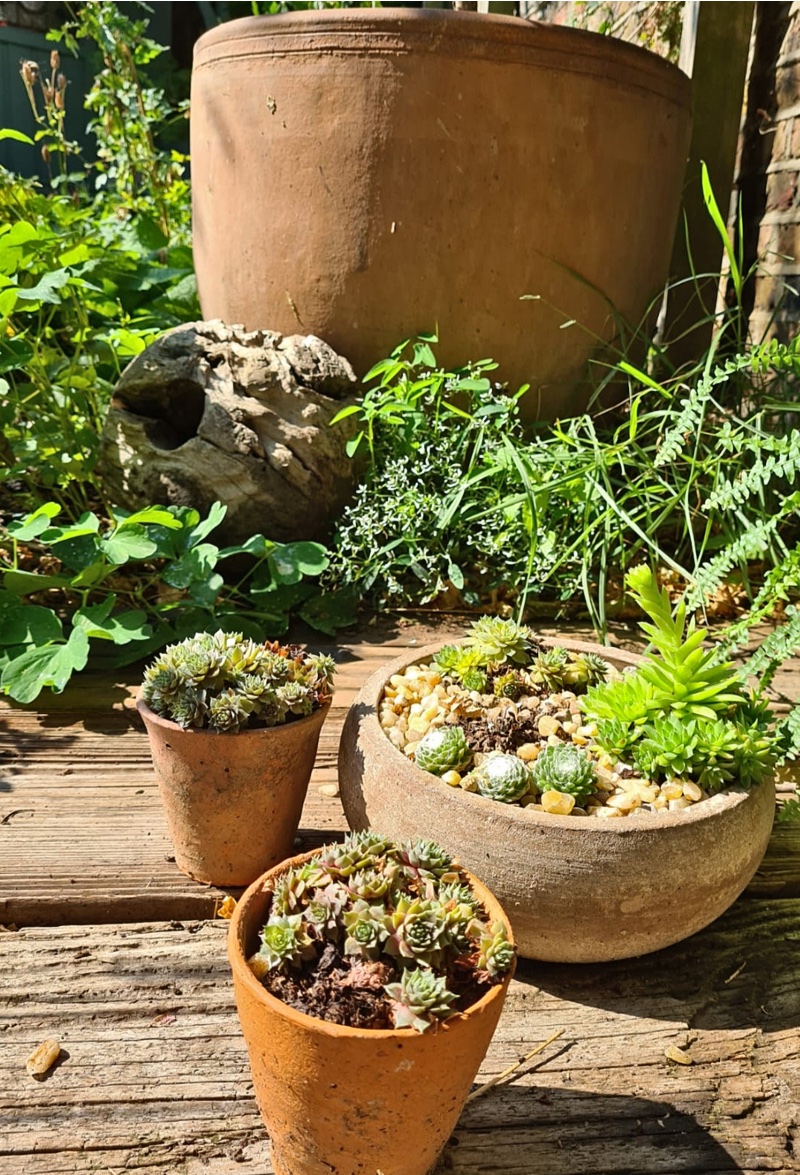
Existing pots and planters were recycled and wildlife friendly planting was retained.
Useful, wildlife friendly planting was retained and any unwanted plants were donated to other gardeners. A mature Elder was a prominent existing feature. What plant can better connect us to the environment and other lifeforms? In winter it looks a wreck and we wonder will it manage to limp on through to spring? But what a change once the sap starts to rise. The leaves come on early, connecting us to the cycle of re-birth out of decay. The summer flowers are an insect magnet and can be made in to refreshing drinks. The autumn berries feed birds and small mammals whilst boosting our immune systems through winter when processed in to medicinal food and drink. Dried out Elder canes are also the best material for the hand drill-one of the first ways our ancestors kindled fire. Try it yourself to fully appreciate their achievements! Plants of this kind re-connect us with our history and birthright and, in doing so, help dispel the illusion that we are somehow ‘outside’ of nature. Through constant exposure to the damaging aspects of our existence we have grown to believe degradation is our hallmark. Gardens are the one of the arenas in which we can reassert the positive elements of human intervention and perhaps see our purpose on this planet.
Specify plants and hardscape that don’t need mollycoddling. Opt for resilient plants and stone and timber types that don’t need constant sealing or cleaning. Reclaimed materials achieve this end and also tick the sustainability box- they have not been newly created and therefore no further finite resources have been consumed. In terms of timber, we used reclaimed Douglas Fir decking and shelving and reclaimed Oak for the seating block/retaining wall in this garden. Reclaimed slate and granite was used for the paving. Jilayne and the client went shopping in local markets for the second hand furniture, fixtures and fittings. All the reclaimed materials were of British provenance. When reclaimed wood cannot be used specify locally sourced FSC-certified timber from trusted suppliers.

Reclaimed timber, slate and granite were used throughout the garden as well as second hand furniture, fixtures and fittings.
Permeable surfaces allow rain water to percolate back in to the ground and to that end gravel was used extensively in this garden. More generally, look to make surfaces more porous with the aim of increasing biodiversity. Block and brick retaining walls could be replaced with gabions which allow unwanted existing materials such as paving and walling to be used as in-fill.
Sustainable gardens aim to be as ‘soft’ as possible. Planting should be diverse, successional and nectar-rich. Utilise a range of trees, shrubs, climbers, grasses and bulbs to provide food and shelter for wildlife. Don’t forget; attractiveness to humans is of equal importance if the garden is to be considered a success by the client!
Go easy on garden lighting and chemical weed and pest control. Neither were used in this scheme.
However, the garden wasn’t a perfect example of sustainability. There were a number of areas where our activities were damaging;
- Cement and adhesives were used. Both material have a high environmental impact.
- Fossil fuels were consumed and pollutants produced in travelling to and from site.
- Space restrictions dictated all deliveries were bagged. To reduce waste specify loose deliveries wherever possible.
- Gravel extraction degrades wildlife habitat.
How can we improve? At Landscaping Solutions we are committed to continual professional development through seminars, courses, workshops and personal study. Integration of environmental assessments to our CDM process helps us think about how we can reduce our impact and guides our landscape design decisions and installation techniques. This is a great tool but can only take us so far due to the fact that much of the raw information is based on intuition. There is a need to develop an industry accepted framework to help us better understand the relative impact of various materials and practices. For instance, we might assume artificial turf to be more impactful than paving but in some instances artificial turf allows the ground to ‘breath’ more than paving. Leave artificial turf to its own devices and it develops into ‘habitat’ much quicker than paving, rapidly hosting an array of plant and invertebrate life. However, can it be recycled satisfactorily? And which of these is most environmentally impactful; quarried British Yorkstone or Italian porcelain? What about quarried Indian sandstone v Italian porcelain? Or Indian sandstone v Indian porcelain. Yorkstone v Portland Stone? Portland stone from open cast extraction v undersea deposits? These are complicated questions.
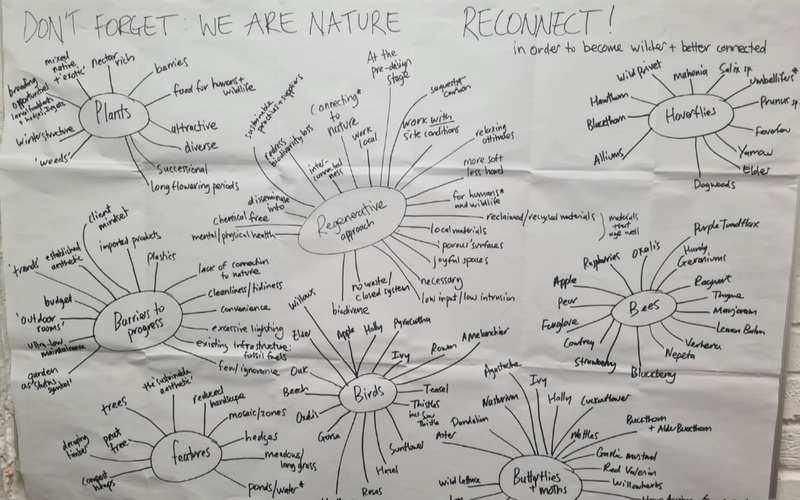
Regular brainstorming sessions helped guide our design decisions and installation techniques.
Good reliable information will enable us to compile a database of suppliers employing sustainable practices. For ‘The Urban Retreat’ we used Ashwells Timber and CED Stone.
Responsive clients might be encouraged to engage with food production be it wild or cultivated and on whatever scale possible. This takes the pressure off the industrial agricultural system, promotes personal resilience, self-sufficiency, understanding of our role in the ecosystem, empathy with other life forms and mental and physical health. Studies have shown low-input vegetable and fruit allotments to be the most biodiverse land use in the country. They can be further improved by providing a body of water and adding on-site composting facilities.
One last piece of advice; don’t forget to have fun!
REDISCOVERING MOTHER NATURE
Landscaping Solutions MD Ben West explains why we need to get back in touch with nature and that compromise is key.
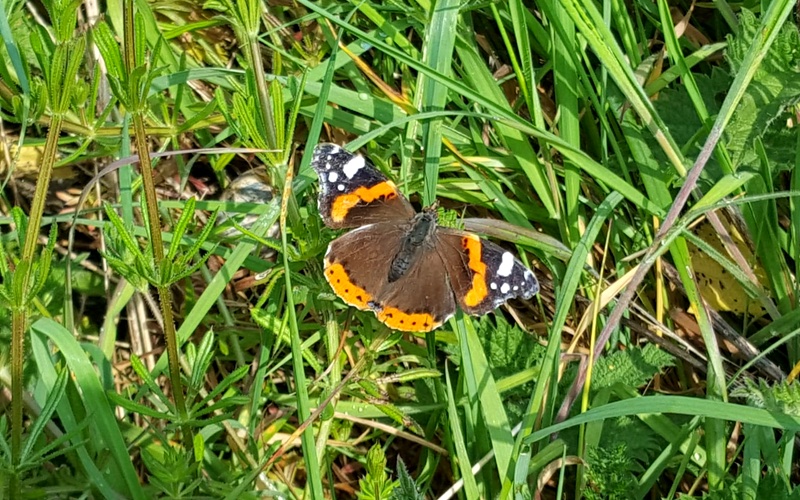
In last months article I focused mainly on the theoretical and practical problems we face in our relationship with the environment. If we are to continue to pursue the goal of ‘economic growth’, this term must come to mean something very different than hitherto. Going forward, all our actions must be scrutinised through the lens of sustainability or regeneration. Our current nescience in this area stems from our conceptual disconnect from nature. I stress ‘conceptual’ because it is all in the mind; literal disconnect from nature is impossible, for what are we but natural through and through? We have lost sight of this truth and therein lies the problem.
Lifestyles and schooling have blinded us to nature and our place in it. Worse still, many of us are filled with fear of plants, insects, fungi and the landscapes they inhabit. Those blind to nature have no incentive to love and nurture it. When we fall out of love, indifference and neglect set in. When we fall out of love with nature, we neglect ourselves.
COVID-19 can rekindle the flame. Nature is courting us again. She has asked us to slow down so that we might renew our acquaintance. The sun is shining, the birds are singing and there’s blossom on the vine. She is giving us another chance to remember who she is and how good we are together. Maybe we could give it another shot? Let’s allow ourselves to fall under her spell once more. Let’s reaffirm our vows, and this time, let’s honour them. We would do well to remember that hell hath no fury like a woman scorned. If we fall back into our gallivanting, will her benevolence endure?
Successful relationships are built on compromise. For this relationship to be more than just a fleeting affair we need to meet her halfway. We need to surrender the conceit of the world as dead matter at our disposal and dismantle our dominator culture in order to learn lessons from life forms far older than us that have evolved to live harmoniously with nature; plants, for instance. They can be the great levellers. Let them be our teachers and the garden our classroom - or more appropriately our forum, for this is a conversation, an exchange of ideas amongst equals.
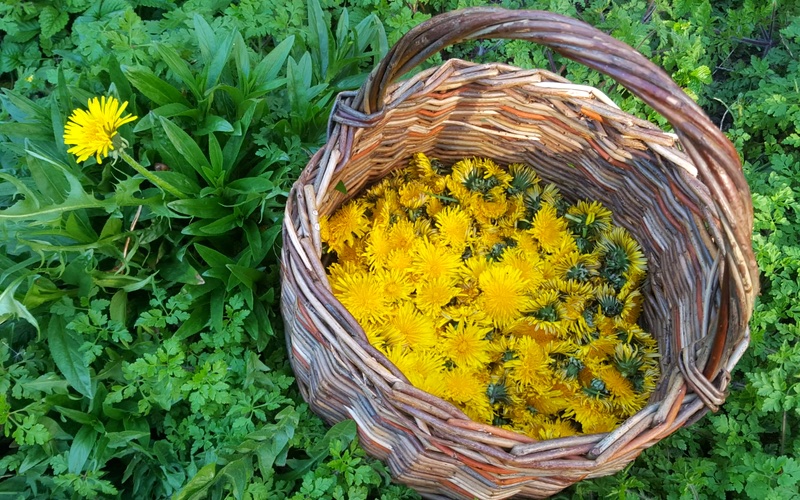
All gardens have something in common whether we like it or not - weeds. I’ve written previously of the biodiversity benefits of allowing weeds to grow. What if I told you consuming weeds can also help us remember who we are? As I write I see before me a host of garden weeds; dandelion, herb robert, nipplewort, plantain, sow thistle, sorrel, ramsons, goosefoot, cleavers, bittercress, burdock. I could go on. All have long nourished and healed us. The rediscovery of a forgotten world of varied flavours and textures, a world beyond the restricted palette of supermarket fruit and veg, is liberating and empowering. It’s also an act of defiance; we are connected once more to our ancestry and environment on a visceral level. Food and medicine are not only found upon shelves, they are products of the feral earth. The health benefits are myriad, both in the inherent nutritional value of the wild foodstuffs and the healing communion with nature. Thousands of years of evolution cannot be quashed in a handful of generations. This stuff is deep within us. Most describe this kind of reconnection as a ‘coming home’.
Weeds in ‘wild’ gardens expose us to a more intimate, egalitarian, interconnected understanding of nature, and thereby of ourselves. A great deal is at stake if we do not regain our capacity to converse with her. Small steps shall set us on our way.
Landscaping Solutions team of talented garden designers and craftspeople are passionate about creating and managing ecological, sustainable and resilient gardens fit for the 21st century. Get in touch to get the ball rolling on your project in 2021.